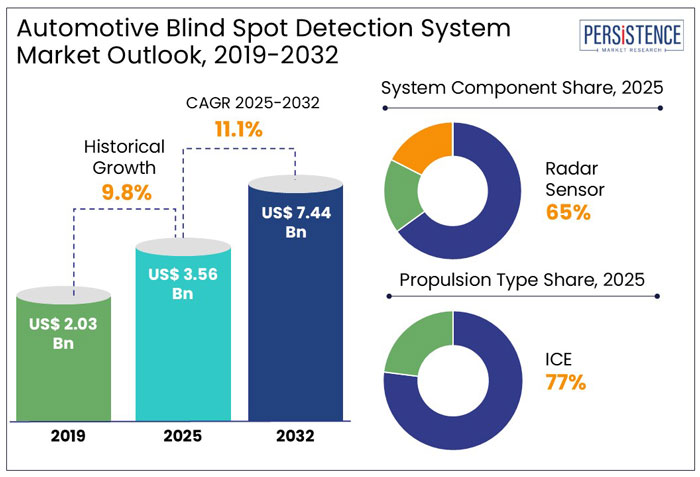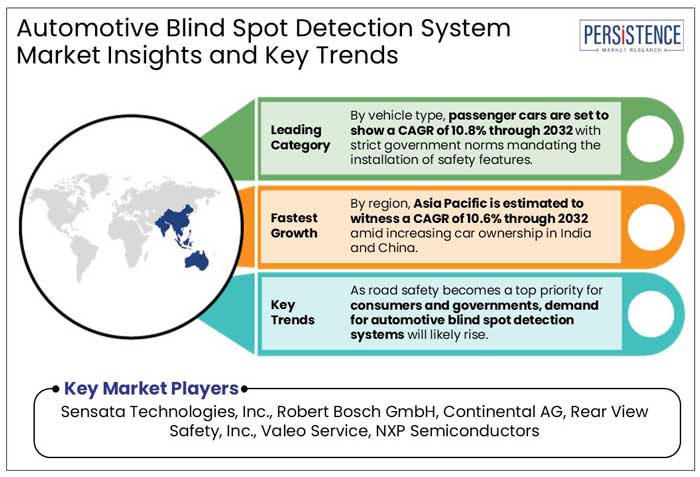Industry: Automotive & Transportation
Published Date: February-2025
Format: PPT*, PDF, EXCEL
Delivery Timelines: Contact Sales
Number of Pages: 182
Report ID: PMRREP35133
The global automotive blind spot detection system market size is anticipated to rise from US$ 3.56 Bn in 2025 to US$ 7.44 Bn by 2032. It is projected to witness a CAGR of 11.1% from 2025 to 2032.
As per Persistence Market Research (PMR), the Automotive Blind Spot Detection (BSD) system market is experiencing significant growth, driven by increasing consumer demand for enhanced vehicle safety with strict government norms. For example,
Growing consumer preference for vehicles equipped with innovative safety systems, including BSD also contributes to the increased adoption of such technologies in passenger and commercial vehicles.

Key Highlights of the Automotive Blind Spot Detection System Market
|
Global Market Attributes |
Key Insights |
|
Automotive Blind Spot Detection System Market Size (2025E) |
US$ 3.56 Bn |
|
Market Value Forecast (2032F) |
US$ 7.44 Bn |
|
Projected Growth (CAGR 2025 to 2032) |
11.1% |
|
Historical Market Growth (CAGR 2019 to 2024) |
9.8% |
Automakers Integrated Blind Spot Detection to Meet Safety Expectations from 2019 to 2024
The automotive blind spot detection system industry has grown significantly over the past few years, driven by rising consumer demand for enhanced vehicle safety features. From 2019 to 2024, the market was primarily dominated by premium vehicles, where ADAS technologies like BSD were offered as part of the standard safety package. For example,
With increasing road safety awareness, consumers and governments pushed for more sophisticated safety solutions, making BSD systems a vital part of modern cars.
AI-powered Sensors and Sensor Fusion Technologies to Enhance Accuracy of BSD Systems through 2032
Over the forecast period, the market is set to experience accelerated growth due to advancements in autonomous driving technology and ADAS integration. With Level 2+ and Level 3 autonomous vehicles becoming more mainstream, BSD systems will evolve, providing high accuracy and safety. For example,
Increasing focus on affordable safety features has led to the adoption of BSD in mid-range and economy vehicles. Emerging markets like Asia Pacific are rapidly adopting these technologies as consumer safety awareness rises and regulatory frameworks become more stringent. Integrating AI-powered sensors and sensor fusion technologies will likely further enhance system reliability, creating long-term growth opportunities for manufacturers.
Growth Drivers
Integration of Lane-keeping Assistance and Collision Warning to Push Demand for BSD Technology
As road safety becomes a top priority for consumers and governments, demand for advanced driver assistance systems (ADAS), including blind spot detection (BSD) systems, is growing rapidly. Drivers are increasingly aware of the risks posed by blind spots, leading to a higher demand for technology that enhances safety and provides peace of mind on the road. For example,
The shift is particularly evident in premium vehicles, but as safety standards improve and evolve, mainstream and economy vehicles are also adopting BSD technology. Governments in various regions, including Europe and North America, are tightening vehicle safety regulations, often making certain safety features mandatory. Growing consumer focus on novel safety features, such as lane-keeping assistance, adaptive cruise control, and collision warning systems, pushes the demand for integrated solutions like BSD.
Economy Car Manufacturers to Prioritize Basic Driver Assistance over Innovative BSD Features
BSD technology is still mostly found in mid-range and luxury vehicles, leaving entry-level and budget cars behind. Various economy car manufacturers focus on keeping production costs low. Hence, safety features like BSD are often omitted in favor of basic driver assistance systems such as rearview cameras or parking sensors. For instance,
The gap in adoption is especially noticeable in emerging markets, where vehicle affordability is a key purchasing factor. Even though governments are pushing for strict road safety regulations, BSD systems are not yet mandated in several regions, leading to slower adoption. To accelerate growth, manufacturers must develop scalable BSD solutions that can be easily integrated into all vehicle segments, not just premium models.
Next-gen BSD Technology with AI and Sensor Fusion to Strengthen Self-driving Capabilities
As vehicles get smarter and safer, BSD systems are seamlessly integrated into Advanced Driver Assistance Systems (ADAS) and autonomous driving technologies. For example,
Traditional BSD sensors are evolving to work alongside lane departure warning, adaptive cruise control, and collision avoidance systems, creating a 360-degree safety net for drivers. Automotive manufacturers invest heavily in Level 2+ and Level 3 autonomous features, making BSD systems more intelligent, proactive, and essential for self-driving capabilities.
Radar, LiDAR, and AI-powered cameras will likely enhance BSD accuracy, making roads safer. Companies that develop next-gen BSD technology with AI-driven object detection and sensor fusion are set to gain a competitive edge as self-driving developments accelerate.
System Component Insights
Pairing Radar Sensors with Lane Change Assist and Cross Traffic Alert to Broaden their Utility
Radar sensors are set to hold the largest automotive blind spot detection system market share of 65% in 2025. This dominance is driven by their high accuracy, reliability in all weather conditions, and superior object detection capabilities compared to cameras and ultrasonic sensors. For example,
Radar sensors can detect vehicles, motorcycles, and obstacles in the blind spot at distances of up to 50 meters, making these ideal for highway driving and urban traffic. Unlike cameras, radar sensors function effectively in low visibility conditions like fog, rain, and snow, ensuring consistent performance. Radar sensors are commonly paired with lane change assist and rear cross traffic alert, enhancing their utility beyond simple blind spot monitoring.
Propulsion Type Insights
Widespread Ownership of ICE Vehicles to Augment Retrofitting of Blind Spot Detection Safety Features
The global demand for Internal Combustion Engine (ICE) vehicles remains high, leading to a substantial existing market for BSD system integration. The segment will likely generate a share of 77% in 2025. Several owners of older ICE vehicles opt to retrofit their cars with unique safety features like BSD systems, enhancing vehicle safety without purchasing new models. For example,
ICE vehicles often have extended lifecycles, maintaining a consistent demand for safety upgrades over time. As the automotive industry shifts toward electrification, the EV segment's share in the BSD system market is set to rise. With the vast number of ICE vehicles currently in use, they are anticipated to remain a significant segment for BSD system deployment in the near future.

Surging Popularity of Electric and Driverless Vehicles Fuels Demand for Safety Technologies in Asia Pacific
Asia Pacific is anticipated to lead the global market for automotive blind spot detection systems, with 36% of the total share in 2025 and witness a 10.6% CAGR through 2032. The region's growth is driven by its burgeoning automotive sector and escalating disposable income, resulting in increased car ownership and demand for sophisticated safety features. For instance,
Increasing trend of electric and driverless vehicles further propels the region's demand for innovative safety technology.
Regulatory Mandates and Safety Innovations to Strengthen North America’s Position
The automobile blind spot detection system market in North America, especially in the U.S. and Canada, is rising due to increasing demand for improved safety features and rigorous regulatory requirements. The region's booming automotive sector, characterized by a significant presence of domestic and international automobile manufacturers, propels innovation and the implementation of Advanced Driver Assistance Systems (ADAS), further fostering market growth.
Rising consumer awareness regarding road safety and an increasing inclination toward luxury vehicles featuring unique safety systems propel market expansion in the region. For example,
The U.S. government is progressively enforcing regulations requiring enhanced safety features in new automobiles, augmenting the demand for blind spot detection systems.
Europe’s Blind Spot Detection System Market Rises as Automakers Embrace Advanced Driver Assistance Technologies
The European automotive blind spot detection system market is projected to witness a moderate CAGR over the forecast period. The European Union's (EU) stringent safety regulations and incentives for integrating sophisticated safety systems facilitate market expansion. For example,
Europe-based automakers are pioneers in adopting advanced ADAS technology in premium and standard automobiles. The market is set to be used by consumer desire for unique technological features and increasing trend of autonomous driving technologies.
The automotive blind spot detection system market is highly competitive, driven by advancements in Advanced Driver Assistance Systems (ADAS) and increasing safety regulations. Leading players in the industry are leveraging cutting-edge radar and camera-based BSD technologies. With the growing adoption of passenger cars and commercial vehicles, manufacturers are integrating BSD with lane departure warnings and adaptive cruise control for enhanced safety.
Premium automakers lead the adoption, while mid-range brands rapidly integrate BSD to meet NCAP safety ratings. Emerging players from China and South Korea offer cost-effective BSD solutions, intensifying competition. As autonomous driving advances, BSD systems will likely evolve with AI-driven object detection and sensor fusion, shaping future market growth.
Key Industry Developments
|
Report Attributes |
Details |
|
Historical Data/Actuals |
2019 - 2024 |
|
Forecast Period |
2025 - 2032 |
|
Market Analysis Units |
Value: US$ Bn/Mn, Volume: As applicable |
|
Geographical Coverage |
|
|
Segmental Coverage |
|
|
Competitive Analysis |
|
|
Report Highlights |
|
|
Customization and Pricing |
Available upon request |
By System Component
By Vehicle Type
By Propulsion Type
By Region
To know more about delivery timeline for this report Contact Sales

The market is set to reach US$ 3.56 Bn in 2025.
Sensata Technologies, Inc., Robert Bosch GmbH, and Continental AG are a few leading players.
The industry is estimated to rise at a CAGR of 11.1% through 2032.
North America is projected to hold the largest share of the industry in 2025.
The market is anticipated to reach a value of US$ 7.44 Bn by 2032.